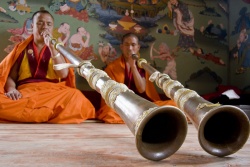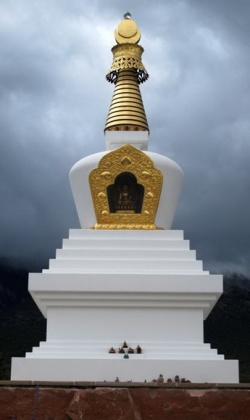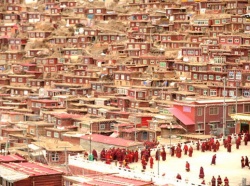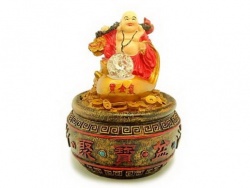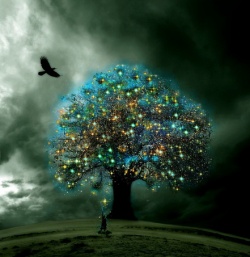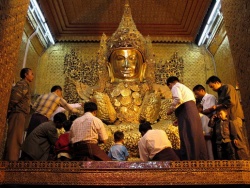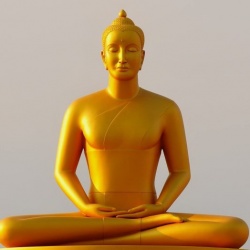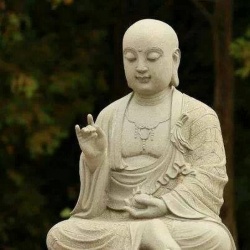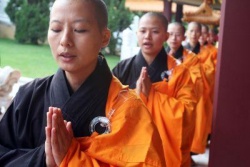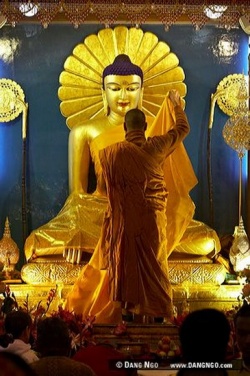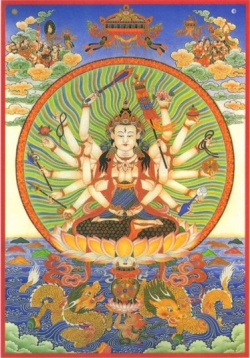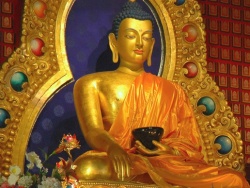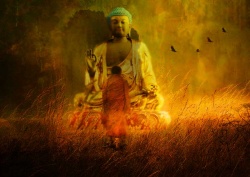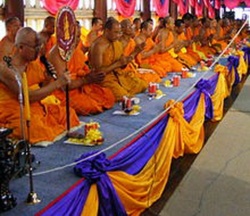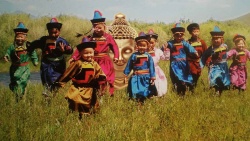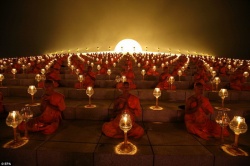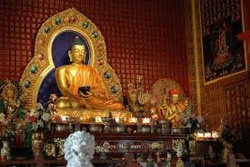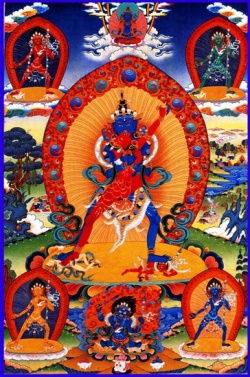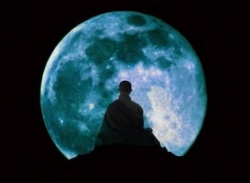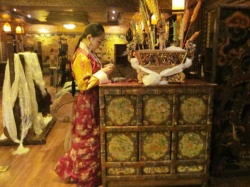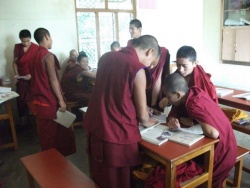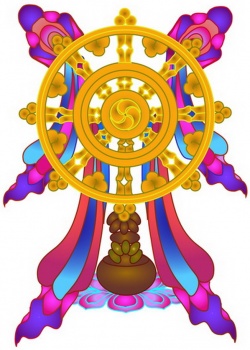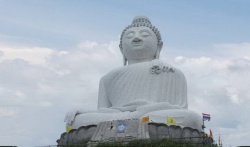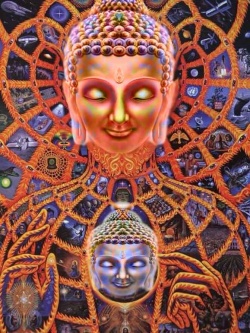Buddhist calendar
By the time Christianity appeared, Buddhism was declining in India. By the 5th century it was being absorbed into Hinduism, and by the 12th century it no longer existed as a viable force in India. It spread throughout Asia, however, where it took firm hold in the ensuing centuries, coexisting with or merging with indigenous religions and philosophies, among them the Confucianism and Taoism of China, the Shintoism of Japan, and the Bon of Tibet.
Various schools and sects have emerged; the two major ones are Mahayana and Teravada Buddhism. Mahayana Buddhism (sometimes called Northern Buddhism) holds that all have the potential for enlightenment and emphasizes faith in the Buddha, love of humanity, compassion, charity, and altruism. The Buddha is considered to be an eternal being, an embodiment of absolute truth, who occasionally takes human form. There have been many Buddhas throughout the centuries. Mahayana Buddhism is largely found in China, Japan, Korea, Tibet and Mongolia.
Teravada Buddhism (sometimes called Southern Buddhism) holds out salvation to the monks and nuns who join the community, and prescribes a discipline for individual undertaking. The followers of this sect/school believe there was only one Buddha and he was a human teacher. Teravada Buddhism is largely found in Cambodia, Laos, Myanmar, Sri Lanka and Thailand.
The Teravada Buddhist calendar is a basic luni-solar calendar (much like the Chinese or Ancient Greek calendars). It should be noted that each Teravadan tradition has its own version of the Buddhist calendar, complete with names for the months, the holidays, and even cycles of years. It consists of 12 months which have alternately 29 and 30 days. This alternating length of the month is due to the length of the lunar cycle being 29.54 days in length, very close to 29.5 days. Each year the calendar therefore slips 11 days backwards with respect to the sun's cycle of equinoxes and solstices. To help keep the calendar more or less in check with the sun, the Buddhist calendar inserts a leap month of 30 days every third year. Read more about the Teravada Buddhist calendar below.
Buddhists also have many local traditions and holidays that vary from country to country depending on the ethnic group. In most areas of the world, the holy days are in sync with the phases of the moon. Therefore, they vary from year to year in relation to the Gregorian calendar.
- Nirvana Day is held in mid-February. It commemorates the Death of Siddhartha Gautama, the Buddha.
- The New Year is the same as those in China, Korea and Vietnam, and corresponds to the New Moon in Aquarius, which can fall from late January to mid-February.
- Wesak is the Buddha's Birthday, which falls in April or May. In some traditions, Wesak celebrates the Buddha's Birth, Enlightenment and Death.
- Khao Pansa marks the beginning of the Buddhist Lent. In some countries it is the preferred day for Buddhist men to be ordained as monks. It is celebrated at the Full Moon of the eight lunar month, typically July.
- Boun Ok Pansa marks the end of Lent. It is at the end of the rainy season, in October.
- Bodhi Day, in early December, celebrates the Buddha's Enlightenment in 596 B.C.E.
In the Tibetan Buddhist calendar most months are given numbers; Cambodia, Sri Lanka and Myanmar (previously known as Burma) are the exceptions - they use names.
Buddhist Calendar Months | |
Tibetan Buddhist Month |
Gregorian Equivalent |
1st Month/Moon |
Dec/Jan |
2nd Month/Moon |
Jan/Feb |
3rd Month/Moon |
Feb/Mar |
4th Month/Moon |
Mar/Apr |
5th Month/Moon |
Apr/May |
6th Month/Moon |
May/Jun |
7th Month/Moon |
Jun/Jul |
Leap Day |
Periodically |
8th Month/Moon |
Jul/Aug |
9th Month/Moon |
Aug/Sep |
10th Month/Moon |
Sep/Oct |
11th Month/Moon |
Oct/Nov |
12th Month/Moon |
Nov/Dec |
13th Month/Moon |
Every few years |
Each month is divided into two 2-week periods. The first or light period begins the day after the New Moon of the previous month and ends with the Full Moon. The second or dark period begins the day after the Full Moon and ends with the New Moon day, which is the last day of the lunar month. The eighth day of each 2-week period is that of the First Quarter and Last Quarter moons, respectively. These four days (FQ, FM, LQ, NM) are known as Uposatha days. These days are observed in the Teravada tradition as days of enhanced practice of the Dhamma. Lay devotees often go to temples or monasteries for the day, undertake the Eight Precepts, and spend the day in meditation, listening to Dhamma talks, and reading about the Dhamma. The practice of observing the Uposatha days as special days of religious practice predates Buddhism. The practice originally comes from ancient India where the four special days of the lunar cycle were set aside for special religious devotions.
Buddhism derives its name from its founder Sakyamuni Buddha. Here he is called Sakyamuni, meaning from the clan of the Sakyas, however, he has been called by many names such as Guatama, Siddartha, and the Buddha, which simply means "The Enlightened One." He was the son of the King of the Sakya clan. In Mahayana Buddhism, the title Buddha may be applied to any historical or even present day enlightened person. Here Buddhism differs from Western religions, which state that there can only one Christ, or Mashiah, or Mahdi, but there have been and may be many Buddhas.
Western religions also have a relatively small number of scriptures, and they have remained unchanged for 1,400 years or more. Buddhism, by contrast, has a huge and ever expanding range of scriptural literature, as a visit to any Gompa on the Annapurna circuit will demonstrate. Like Christianity and Islam, Buddhism includes the life story of its founder within its literature. Buddhists believe in a cycle of birth and rebirth (reincarnation), which ends only with the enlightenment of a soul. Sakyamuni's previous lives as a Boddhisattva are part of his lifestory. A Boddhisattva is someone who has reached the point where his advance in wisdom means that enlightenment is inevitable.
In the Teravada tradition of Buddhism, Sakyamuni is the one and only Buddha. Sakyamuni began his progress toward enlightenment in a previous lifetime when he was a monk called Megha. Megha sought out Dipankara, a Buddha alive at that time. Dipankara, with the supreme knowledge of a Buddha, told Megha that he, Megha, would be the future founder of the Buddhist religion. Now you may be wondering, and indeed you should be wondering, how do we know about Sakyamuni Buddha's past lives? Simple. Buddhas have supreme knowledge. When they become enlightened they can remember all their past lives.
There are four Special Buddha days or Festivals during a year, which relate to the life of Buddha Sakyamuni. During these days, it is said that the effects of positive or negative actions are multiplied 100 million times, so practice is strongly advised.
- Chotrul Duchen: During the first two weeks of the New Year, it is believed that the Buddha displayed a miracle each day to increase the merit and devotion of future disciples. The 15th day is the Day of Miracles. During these days, the Gelugpa Monlam Chenmo (great prayer festival) is celebrated, and practice is strongly advised.
- Saga Dawa Duchen: the 15th day of the 4th month, Buddha Sakyamuni's Enlightenment and Parinirvana are celebrated. He became enlightened during a Full Moon night in Bodhgaya and entered Parinirvana (passed away) in Kushinagar.
- Chokhor Duchen: the 4th day of the 6th month, the First Turning of the Wheel of Dharma (first teaching) is celebrated. For the first seven weeks after his Enlightenment, Buddha did not teach. Encouraged by Indra and Brahma, he then gave his first teachings at Sarnath on the Four Noble Truths. The Four Noble Truths are: Life is suffering and suffering is unavoidable; suffering is caused by desire (karma, attachement, anger and ignorance); suffering can end by eliminating desire (Nirvana is peace);there is a means to eliminate desire and thus suffering called the Eightfold Path (correct speech, conduct, livelihood, effort, mindfullness, concentration, views, and intentions).
- Lha Bab Duchen: the 22nd day of the 9th month, Buddha Sakyamuni's Descent from the Heaven of 33 is celebrated. Buddha's mother had been reborn in Indra's heaven. To repay her kindness and to benefit the gods, Buddha spent three months teaching in the Heaven of 33. Some traditions call it Tushita heaven; this is the realm where the Buddha lived before he descended to Earth.
In the Teravada Buddhist calendar there are three seasons, not four. This reflects the climate of India and Southeast Asia where there is a rainy period for four months out of the year (Vassana), followed by a cool season or winter (Hemanta), which in turn is followed by a hot, dry season, or summer (Gimha).
In the Buddhist year the season of Vassana is a time of special religious practices. During this season monks must remain in their monasteries and avoid traveling long distances. The monks normally devote themselves to their mediation and study during this time. Also, lay devotees often enter the monastic order during this season to pass Vassana as a monk or novice. The Vassana season is flanked by two holidays: Asalha Puja (Dhammacakkapavattana) begins the season, and Pavarana (Abhidhamma) ends it.
The period between the Full Moon of Assayuja to the Full Moon of Kathika is set aside as the special season for making Kathina offerings to the Sangha, particularly offering of new robes. Another major holiday occurs during the Hemanta season, namely Magha Puja on the Full Moon day of the month of Magha.
The Gimha season commences the day after the New Moon day of the month of Phagguna. During this season on the Full Moon day of Visakha, the highest holiday in the Buddhist calendar occurs. Visakha Puja commemorates the Birth, Enlightenment, and Mahaparinibbana of the Buddha. At the end of Gimha, we come around again to the holiday of Asalha Puja, after which Vassana begins again.
The years of the Buddhist Era (B.E.) begin from the traditional date of the Buddha's Mahaparinibbana Death (he passed away at the age of 80). According to traditional sources this event occurred in the year corresponding with 543 BCE. As mentioned above, the Mahaparinibbana occurred on the Full Moon day of Visakha, thus Visakha Puja also serves to usher in a new Buddhist Era year. Visakha Puja in the year 2004 CE was in the Buddhist Era year 2547.
If you would like to know the year in the Buddhist Era, just calculate the following:
{{{1}}}
Not all Buddhists follow this calendar. The Tibetan monks follow a calendar that comes full cycle every 60 years. It is related to the Chinese calendar, with each year named after an animal and an element.
The Life of the Buddha
The name of the Buddha is just an honorary title which means he was Enlightened. His first name was Siddartha, which means "wish fulfilled," and his last name was Guatama. He was born in the year 623 BC in a tiny town called Lumbini, in what is now southern Nepal. His parents were King Suddhodana and Queen Maha-maya.
On the fifth day after his birth, learned Brahmans predicted that he would become either a universal monarch or an Enlightened One (the Buddha).
At the early age of 16, he married his beautiful cousin, princess Yasodhara. He knew no personal grief because his father provided more than he could ever need.
As he lived in a guarded palace, one day he decided to see the world outside. He first saw an old man, then a diseased man, a corpse and a dignified monk. He had never seen such sights before. The first three sights convinced him that beings are subject to birth, decay, disease, death, sorrow and grief, and he then realized he would be as well. The fourth sight, the monk, suggested to him a way to overcome the ills of life, and to attain calm and peace. So, he decided to leave his opulent life to search for truth and eternal peace.
On the day when his first and only son was born he left the palace to become a hermit. At that time he was 29 years old. After searching for the truth for six years, he found it, and at the age of 35, he became known as the Buddha.
The Buddha was the most energetic of all religious teachers. Throughout the 45 years of his ministry, he was constantly occupied with religious activities except when attending to his physical needs, only taking short rests after meals and sleeping about one-and-a-half hours at night. When anyone needed his spiritual guidance, he would undertake even lengthy journeys to help them, on foot or sometimes by using his psychic powers. Even in the last minutes before attaining Parinirvana (passing away), he preached to a person who had another faith and concept, and wanted to know the answers to some problems.
The Buddha's final words were, as ever, pragmatic and encouraging: 'All things are impermanent - strive on with diligence!'
Source
The Buddhist calendar (Pali: Sāsanā Sakaraj; Burmese: သာသနာ သက္ကရာဇ်, [θàðənà θɛʔkəɹɪʔ]; Thai: พุทธศักราช, RTGS: phutthasakkarat, [pʰút.tʰá.sàk.kà.ràːt]) is a set of lunisolar calendars primarily used in mainland Southeast Asian countries of Cambodia, Laos, Myanmar and Thailand as well as in Sri Lanka for religious and/or official occasions. While the calendars share a common lineage, they also have minor but important variations such as intercalation schedules, month names and numbering, use of cycles, etc. In Thailand, the name Buddhist Era is a year numbering system shared by the traditional Thai lunisolar calendar and by the Thai solar calendar.
The Southeast Asian lunisolar calendars are largely based on an older version of the Hindu calendar, which uses the sidereal year as the solar year. One major difference is that the Southeast Asian systems, unlike their Indian cousins, do not use apparent reckoning to stay in sync with the tropical year. Instead, they employ their versions of the Metonic cycle. However, since the Metonic cycle is intended to keep pace with tropical years, not sidereal years, the Southeast Asian calendar is slowly drifting out of sync with the tropical year, approximately one day every 60 years. The traditional New Year's Day, which used to take place around the vernal equinox in the mid-7th century now falls on 17 April today. Yet no coordinated structural reforms of the lunisolar calendar have been undertaken.
Today, the traditional Buddhist lunisolar calendar is used mainly for Theravada Buddhist festivals, and no longer has the official calendar status anywhere. The Thai Buddhist Era, a renumbered Gregorian calendar, is the official calendar in Thailand.
Structure
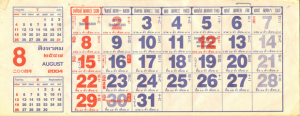
The calculation methodology of the current versions of Southeast Asian Buddhist calendars is largely based on that of the Burmese calendar, which was in use in various Southeast Asian kingdoms down to the 19th century under the names of Chula Sakarat and Jolak Sakaraj. The Burmese calendar in turn was based on the "original" Surya Siddhanta system of ancient India (believed to be Ardharatrika school). One key difference with Indian systems is that the Burmese system has followed a variation of the Metonic cycle. It is unclear from where, when or how the Metonic system was introduced; hypotheses range from China to Europe. The Burmese system, and indeed the Southeast Asian systems, thus use a "strange" combination of sidereal years from Indian calendar in combination with the Metonic cycle intended for tropical years.
Epochal date
In all Theravada traditions, the calendar's epochal year 0 date was the day in which the Buddha attained parinibbāna. However, not all traditions agree on when it actually took place. In Burmese Buddhist tradition, it was 13 May 544 BCE (Tuesdsay, Full moon of Kason 148 Anjanasakaraj).}} But in Thailand, it was 11 March 545 BCE, the date which the current Thai lunisolar and solar calendars use as the epochal date. Yet, the Thai calendars for some reason have fixed the difference between their Buddhist Era (BE) numbering and the Christian/Common Era (CE) numbering at 543,}} which points to an epochal year of 544 BCE, not 545 BCE. In Myanmar, the difference between BE and CE can be 543 or 544 for CE dates, and 544 or 543 for BCE dates, depending on the month of the Buddhist Era (as the Buddhist calendar straddles the Gregorian calendar—currently from April to April).
| BE Year | Equivalent CE Years | Equivalent CE Year (Thai Solar) |
|---|---|---|
| 0 | 544–543 BCE | |
| 1 | 543–542 BCE | |
| 543 | 1 BCE – 1 CE | |
| 544 | 1–2 CE | 1–2 CE |
| 2483 | 1940–1941 | 1940 (Apr–Dec) |
| 2484 | 1941–1942 | 1941 |
| 2556 | 2013–2014 | 2013 |
Month
Types
The calendar recognizes two types of months: synodic month and sidereal month.}} The Synodic months are used to compose the years while the 27 lunar sidereal days (Sanskrit: nakshatra), alongside the 12 signs of the zodiac, are used for astrological calculations.}} (The Burmese calendar also recognizes a solar month called Thuriya Matha, which is defined as 1/12th of a year.}} But the solar month varies by the type of year such as tropical year, sidereal year, etc.)
Waxing and waning
The days of the month are counted in two halves, waxing and waning. The 15th of the waxing is the civil full moon day. The civil new moon day is the last day of the month (14th or 15th waning). Because of the inaccuracy of the calendrical calculation systems, the mean and real (true) New Moons rarely coincide. The mean New Moon often precedes the real New Moon.
| Type | Days | Description |
|---|---|---|
| Waxing | 1 to 15 | from New Moon to Full Moon |
| Full Moon | 15 | Full Moon |
| Waning | 1 to 14 or 15 | from Full Moon to New Moon |
| New Moon | 15 | New Moon |
Number of days per month
As the Synodic lunar month is approximately 29.5 days, the calendar uses alternating months of 29 and 30 days.
| Sanskrit | Pali | Burmese | Khmer | Lao | Sinhala | Thai | # of days | ~Gregorian |
|---|---|---|---|---|---|---|---|---|
| Caitra | Citta | Tagu (တန်ခူး) | ចេត្រ | Bak (බක්) | Chittra (จิตร) | 29 | March–April | |
| Vaisākha | Visakha | Kason (ကဆုန်) | ពិសាខ | Vesak (වෙසක්) | Wisakha (วิสาข) | 30 | April–May | |
| Jyaiṣṭha | Jeṭṭha | Nayon (နယုန်) | ជេស្ឋ | Poson (පොසොන්) | Chettha (เชษฐ) | 29 [30] | May–June | |
| Āṣāḍha | Āsāḷha | Waso (ဝါဆို) | អាសាធ | Æsala (ඇසළ) | Asanha (อาสาฬห) | 30 | June–July | |
| Śrāvaṇa | Sāvaṇa | Wagaung (ဝါခေါင်) | ស្រាពណ៍ | Nikini (නිකිණි) | Sawana (สาวน) | 29 | July–August | |
| Bhādrapada | Poṭṭhapāda | Tawthalin (တော်သလင်း) | ភទ្របទ | Binara (බිනර) | Phatthrabot (ภัทรบท) | 30 | August–September | |
| Āśvina | Assayuja | Thadingyut (သီတင်းကျွတ်) | អស្សុជ | Wap (වප්) | Atsawayut (อัศวยุช) | 29 | September–October | |
| Kārttika | Kattikā | Tazaungmon (တန်ဆောင်မုန်း) | កក្ដិក | Il (ඉල්) | Kattika (กัตติกา) | 30 | October–November | |
| Mārgaśirṣa | Māgasira | Nadaw (နတ်တော်) | មិគសិរ | Undhuvap (උඳුවප්) | Mikkhasira (มิคสิร) | 29 | November–December | |
| Pauṣa | Phussa | Pyatho (ပြာသို) | បុស្ស | Dhuruthu (දුරුතු) | Putsa (ปุสส) | 30 | December–January | |
| Māgha | Māgha | Tabodwe (တပို့တွဲ) | មាឃ | Navam (නවම්) | Makha (มาฆ) | 29 | January–February | |
| Phālguna | Phagguṇa | Tabaung (တပေါင်း) | ផល្គុន | Mædhin (මැදින්) | Phakkhun (ผัคคุณ) | 30 | February–March |
Month numbering
Various regional versions of Chula Sakarat/Burmese calendar existed across various regions of mainland Southeast Asia. Unlike Cambodian and Burmese systems, Kengtung, Lan Na, Lan Xang and Sukhothai systems refer to the months by numbers, not by names. This means reading ancient texts and inscriptions in Thailand requires constant vigilance, not just in making sure one is correctly operating for the correct region, but also for variations within regions itself when incursions cause a variation in practice.
| Month | Lan Xang, Sukhothai, (and Old Burmese) | Kengtung | Chiang Mai |
|---|---|---|---|
| Caitra | 5 | 6 | 7 |
| Vaisakha | 6 | 7 | 8 |
| Jyestha | 7 | 8 | 9 |
| Ashadha | 8 | 9 | 10 |
| Sravana | 9 | 10 | 11 |
| Bhadrapada | 10 | 11 | 12 |
| Asvina | 11 | 12 | 1 |
| Karttika | 12 | 1 | 2 |
| Margasirsa | 1 | 2 | 3 |
| Pausa | 2 | 3 | 4 |
| Magha | 3 | 4 | 5 |
| Phalguna | 4 | 5 | 6 |
Year
The Buddhist calendar is a lunisolar calendar in which the months are based on lunar months and years are based on solar years. One of its primary objectives is to regulate the lunar part that it will keep pace with the solar part. The lunar months, normally twelve of them, consist alternately of 29 days and 30 days, such that a normal lunar year will contain 354 days, as opposed to the solar year of ~365.25 days. Therefore some form of addition to the lunar year (of intercalation) is necessary. The overall basis for it is provided by cycles of 57 years. Eleven extra days are inserted in every 57 years, and seven extra months of 30 days are inserted in every 19 years (21 months in 57 years). This provides 20819 complete days to both calendars.}}
As such, the calendar adds an intercalary month in leap years and sometimes also an intercalary day in great leap years. The intercalary month not only corrects the length of the year but also corrects the accumulating error of the month to extent of half a day. The average length of the month is further corrected by adding a day to Nayon at irregular intervals—a little more than seven times in two cycles (39 years). The intercalary day is never inserted except in a year which has an intercalary month.}} The Hindu calendar inserts an intercalary month at any time of year as soon as the accumulated fractions amount to one month. The Burmese calendar however always inserts the intercalary month at the same time of the year, after the summer solstice while the Arakanese calendar inserts it after the vernal equinox.}}
Burmese
The actual Burmese calendar year consists of 354, 384 or 385 days.
| Month | Regular year | Small leap year | Big leap year |
|---|---|---|---|
| Tagu | 29 | 29 | 29 |
| Kason | 30 | 30 | 30 |
| Nayon | 29 | 29 | 30 |
| Waso | 30 | 30 | 30 |
| 2nd Waso | n/a | 30 | 30 |
| Wagaung | 29 | 29 | 29 |
| Tawthalin | 30 | 30 | 30 |
| Thadingyut | 29 | 29 | 29 |
| Tazaungmon | 30 | 30 | 30 |
| Nadaw | 29 | 29 | 29 |
| Pyatho | 30 | 30 | 30 |
| Tabodwe | 29 | 29 | 29 |
| Tabaung | 30 | 30 | 30 |
| Total | 354 | 384 | 385 |
Note: The Arakanese calendar adds the intercalary day in Tagu, not in Nayon.
Cambodian, Lao and Thai
The Cambodian, Lao and Thai lunar calendars use a slightly different method to place the intercalary day. Instead of it in a leap year as in the Burmese system, the Thai system places it in a separate year. Thus, the Thai small leap year has 355 days while the Thai great leap year has 384 days.
| Month | Regular year | Small leap year | Big leap year |
|---|---|---|---|
| Caitra | 29 | 29 | 29 |
| Vaisakha | 30 | 30 | 30 |
| Jyestha | 29 | 30 | 29 |
| Ashadha | 30 | 30 | 30 |
| 2nd Ashadha | n/a | n/a | 30 |
| Sravana | 29 | 29 | 29 |
| Bhadrapada | 30 | 30 | 30 |
| Asvina | 29 | 29 | 29 |
| Karttika | 30 | 30 | 30 |
| Margasirsa | 29 | 29 | 29 |
| Pausa | 30 | 30 | 30 |
| Magha | 29 | 29 | 29 |
| Phalguna | 30 | 30 | 30 |
| Total | 354 | 355 | 384 |
New year's day
Since the main purpose of Buddhist calendar is to keep pace with the solar year, the new year is always marked by the solar year, which falls at the time when the Sun enters Aries. The date, which at the present falls on the 17th of April, has slowly drifted over the centuries. In the 20th century, the New Year's Day fell on April 15 or 16th but in the 17th century, it fell on April 9 or 10th. Thailand no longer uses the traditional lunisolar calendar to mark the New Year's Day.
| Tradition | Date in 2013 | Notes |
|---|---|---|
| Burmese | 17 April | Varies; will keep on drifting away |
| Thai | 13 April | Fixed to the solar calendar |
Cycle
Cambodian and Thai systems give animal names to the years from a cycle of 12. The practice also existed in Burma in the Pagan period but later died out.
| Year | Animal |
|---|---|
| 1 | Rat |
| 2 | Ox |
| 3 | Tiger |
| 4 | Hare |
| 5 | Dragon |
| 6 | Snake |
| 7 | Horse |
| 8 | Goat |
| 9 | Monkey |
| 10 | Rooster |
| 11 | Dog |
| 12 | Pig |
Accuracy
The Southeast Asian Buddhist calendars use lunar months but try to keep pace with the solar year, by inserting intercalary months and days on the Metonic cycle (in the case of the Burmese calendar, on a modified Metonic cycle). However, the solar year as defined by the Buddhist calendars is really a sidereal year, which is nearly 24 minutes ahead of the actual mean tropical year. Therefore like all sidereal-based calendars, the lunisolar calendars are slowly drifting away from the seasons.}} The calendars are drifting one day approximately every 60 years and 4 months.
The accumulating error means the New Year's Day which used to fall on 22 March (near the vernal equinox) in 638 CE now falls on 17 April in 2013 CE. There is no known internationally concerted effort to correct the calendar. Thailand has moved its "Buddhist Era" to the Gregorian calendar under the name of Thai solar calendar. In Myanmar, Burmese calendarists have tried to deal with the issue by periodically modifying the intercalation schedule in the Metonic cycle. One major downside of this approach is that it is not possible to publish future calendars more than a few years (often even a year) ahead.
History
The Buddhist Era was first introduced to Southeast Asia along with Buddhism in the early centuries CE. It was not a separate calendar but simply a year numbering system that employed the organization and calculation methods of the prevailing lunisolar calendars in use throughout the region. In the early centuries CE, the reference civil calendar of the Buddhist calendar prevalent in Southeast Asia was the Mahāsakaraj Era, which is said to have been adopted by the Pyu state of Sri Ksetra in 80 CE. The Mahāsakaraj Era was gradually replaced by the Burmese Era or Culāsakaraj, first in Myanmar in 640 CE,}} and in other Theravada kingdoms of Southeast Asia between the 13th and 16th centuries. Theravada Buddhist tradition also recognizes pre-Buddhist Anjana Sakaraj (Añjana's Era) since the events of the Buddha's life are recorded in that era.}}
| Name | Epochal date | Notes |
|---|---|---|
| Anjana Sakaraj | 10 March 691 BCE | Said to have been started by the Buddha's maternal grandfather King Añjana Used to date the events during the Buddha's lifetime |
| Buddhist Era | 13 May 544 BCE 11 March 545 BCE |
544 BCE in Myanmar; 545 BCE in Thailand |
| Mahāsakaraj | 17 March 78 CE | Civil calendar |
| Burmese Era (Culāsakaraj) | 22 March 638 | Civil calendar |
The tradition of using different reference calendars continued in Siam in 1912 when King Vajiravudh decreed that the Buddhist Era would now track the Thai solar calendar, the Siamese version of the Gregorian calendar with the New Year's Day of 1 April. Therefore the Thai Buddhist Era year of 2455 began on 1 April 1912 (as opposed to 15 April 1912 according to the lunisolar calendar}}). The Thai Buddhist Era was further realigned to the Gregorian calendar on 6 September 1940 when Prime Minister Phibunsongkhram decreed 1 January 1941 as the start of the year 2484 BE. As a result, the Year 2483 was only 9 months long, and the Thai Buddhist Era equals that of the Common Era plus 543 years.
Current usage
The lunisolar calendar is used to mark important Buddhist holidays. Many of the holidays are celebrated as public holidays.
| Buddhist calendar date | International date | Public holiday in | Notes |
|---|---|---|---|
| Full moon of Pausa | January | Sri Lanka | Duruthu Poya: Commemorates the first visit of the Buddha to Sri Lanka |
| Full moon of Magha | February | Cambodia, Laos, Sri Lanka, Thailand | Magha Puja in Cambodia, Laos, Thailand and Navam Poya in Sri Lanka |
| Full moon of Phalguna | March | Laos, Myanmar, Sri Lanka | Boun Pha Vet (Laos), Tabaung Festival (Myanmar), Medin Poya (Sri Lanka) |
| Almost always in Caitra, sometimes in Vaisakha | 13–17 April (varies by country) |
Cambodia, Laos, Myanmar, Sri Lanka, Thailand | New Year's Day Traditionally, the New Year's Day is marked when the Sun enters Aries but the day is now fixed in most countries; Myanmar still follows the tradition |
| Full moon of Caitra | April | Sri Lanka | Bak Poya: Commemorates the second visit of the Buddha to Sri Lanka |
| Full moon of Visakha | May | Cambodia, Laos, Myanmar, Thailand, Sri Lanka | Buddha Day |
| Full moon of Jyaistha | June | Sri Lanka | Poson Poya: Commemorates introduction of Buddhism to Sri Lanka |
| Full moon of Ashadha | July | Cambodia, Laos, Myanmar, Thailand, Sri Lanka | Start of Buddhist Lent |
| Full moon of Sravana | August | Sri Lanka | Nikini Poya |
| Full moon of Bhadrapada | September | Laos, Sri Lanka | |
| Full moon of Asvina | October | Cambodia, Laos, Myanmar, Sri Lanka | End of Buddhist Lent |
| Full moon of Karttika | November | Laos, Myanmar, Sri Lanka, Thailand | That Loung Festival (Laos); Tazaungdaing Festival (Myanmar); Il Poya (Sri Lanka); {{Wiki|Loi Krathong]] (Thailand) |
| Full moon of Margasirsa | December | Sri Lanka | Undhuvap Poya (Sri Lanka) |
Source
The Buddhist calendar was established in classical times and set to the traditional Chinese lunar calendar. The Buddhist calendar is used throughout the Chinese Buddhist cultural sphere as well as in other countries like Japan. Events noted on the Buddhist calendar can be divided into two major groups: shared and exclusive holidays.
The shared holidays begin with the New Year Festival held in the first month on the first day (1/1) of the Chinese lunar calendar (see calendars and almanacs). This is celebrated by Buddhists as the Bodhisattva Maitreya’s birthday. This is followed by the Dipamkara Buddha’s birthday on the sixth day (1/6), Yama’s on 1/8, and Indra’s on 1/9, which is the last day of the Chinese New Year. However, the Lantern Festival on 1/15 is also widely celebrated at Buddhist temples.
Shakyamuni’s Great Renunciation is celebrated on 2/8, while 2/15 is considered his day of extinction/nirvana and is also considered the birthday of the Chinese deity Guan Di. The Bodhisattva Avalokiteshvara’s birthday is on 2/19 (see Guanyin), the Bodhisattva Samantabhadra’s birthday on 2/21, and the Bodhisattva Chundi’s birthday on 3/16. The next holiday is on 4/4, which is the Bodhisattva Manjusri’s birthday. This is followed by Shakyamuni Buddha’s birthday on 4/8, Bodhisattva Bhaisajaraja’s birthday on 4/28, and Bodhisattva Sangharama’s birthday on 5/13.
The Bodhisattva Weito’s birthday is on 6/3, the Dragon King’s day on 6/13, the Bodhisattva Avalokiteshvara’s realization day on 6/19, and the Bodhisattva Mahasthamaprapta’s birthday on 7/13. These are all single-day events. The celebration of Ullambana takes place on 7/15, but is usually accompanied by many activities for a couple of weeks in and around this date (see Gongde). On 7/24 the founder of the Madhyamaka school Nagarjuna’s birthday is celebrated. On 7/30 the Bodhisattva Ksitigarbha-raja’s birthday is celebrated. The remote Buddha Dipamkara’s birthday is held on 8/22. On 9/19 the Bodhisattva Avalokiteshvara’s ordination is celebrated. On 9/30 is the Medicine Buddha Bhaisajaguru’s birthday. The tenth month has no holiday and 11/17 is considered Buddha Amita’s birthday. The last month of the year has two celebrations: on 12/8 is the day of Buddha Shakyamuni’s ‘awakening’, and 12/29 is the Bodhisattva Avatamsaka’s birthday. This concludes the shared holidays.
However, there are also exclusive holidays for the Patriarch Huineng’s ordination on 1/15, Bodhidharma’s birthday on 10/8, and the Patriarch Pu’an’s birthday on 7/21. These are all important to the Chan tradition. The Tiantai master Zhiyi’s anniversary is held on 11/4, while the death of the Pure Land Master Huiyuan is remembered on 8/6. Days are also set aside for the founders of temples, monasteries, schools and sects, and there are other holidays exclusive to specific lineages that are of concern primarily to monks and nuns. For personal cultivation, either the 1st, 8th, 14th, 15th, 18th, 23rd, 24th and the last three days of each month, or, alternatively, the 8th, 14th, 15th, 23rd and the last three days of each month are considered days of abstinence. Furthermore, 1/8, 2/7, 2/9, 2/19, 3/3, 3/6, 3/13, 4/22, 5/3, 5/17, 6/16, 6/18, 6/19, 6/23, 7/13, 8/16, 9/19, 9/23, 10/2, 11/19, 11/24 and 12/25 are considered special abstinence days in honour of the Bodhisattva Avalokiteshvara.
A.W.BARBER
